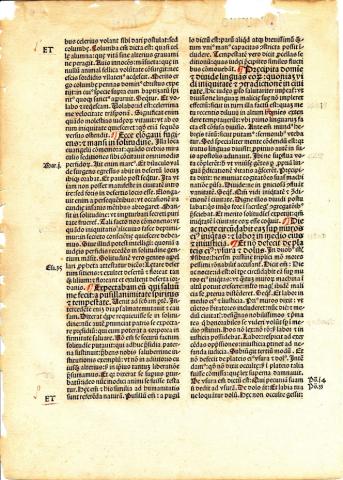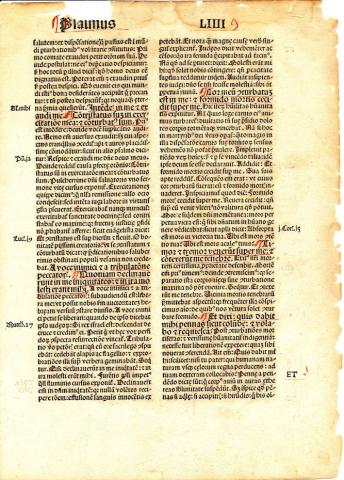Cassiodorus Leaf from In Psalterium Expositio | Commentary on the Psalms
Cassiodorus Leaf from In Psalterium Expositio [commentary on the Psalms]
Basel, 1491
Printer: Johann de Amerbach
Portland State University Special Collections, Shipley 18
Tyler Holland, Medieval Portland Capstone Student, 2016
This leaf is a single page from Cassiodorus’ Psalterium Expositio. It is a historically significant and rare document printed in the late 15th century from the early years of printing.
This leaf, housed in Portland State University’s Special Collections, is in relatively good condition. The top of the leaf has mild discoloration consistent with moisture damage. Above the text heading, there is a rectangle-shaped gap where the paper material has been torn. The top right corner has also been torn off. These two missing fragments are the only two sizable tears. The edges of the document are fraying in a manner that is expected for a document of this age.
Both sides of the document consist of two columns of bold face gothic text. Both the left and right margins contain printed references consistent with the typeset of the body. On the front there is a heading that reads “Plaumus”(Psalms) above the left column and “LIIII”(54) above the right. Throughout the document there are handmade red markings, mainly consisting of underlining. This document, along with the other twenty-one folio leafs in the Shipley collection, were once a part of a collection known as the “Pages from the Past: Original Leaves from Rare Books and Manuscripts”, collected by Foliophiles, Inc. The Cassiodorus Leaf has been removed from its original folio by the controversial practice of biblioclasty.
Johann de Amerbach printed The Cassiodorus Leaf in 1491. At the end of the fifteenth century, Amerbach settled in Basel, Switzerland, where he started the Basel printing house. He rose to prominence in the emerging printing industry, producing books in a quantity that could only be rivaled by one other printer in the city.[1] His first major publication was in 1478. He continued this work until his death in 1513.
Amerbach spent the first part of his career focused on the “academic and ecclesiastical markets,”[2] making Cassiodorus’ commentary a prime candidate for the Basel printing house. Cassiodorus frequently wrote on theology, as is seen in the Amerbach leaf. He began his Commentary on the Psalms around the year 540 and completed it in 548. In the 560’s he reworked the commentary. Halporn notes, “His most important innovation at this time was the addition of marginal ‘notae’, which refer to content and which operate as a kind of indexing system."[3]
The text on this leaf includes Cassiodorus’ commentary from verse two to verse twelve of what is now considered to be Psalm 55. Cassiodorus made a direct correlation between David and Christ Jesus. In verse three, David pleads with God to listen to his cries: “I am grieved in my exercises and am troubled.”[4] In his commentary on the third verse, Cassiodorus states, "The course of the Lord Savior's life is most beautifully expounded in this single statement.”[5] This pattern continues into verse four when Cassiodorus connects David’s statement “From the voice of the enemy and the tribulation of the sinner...”[6] to Christ's death and resurrection. Cassiodorus writes:
He [Jesus] sought to be delivered from the voice of the enemy when the Jewish people said to him: “If he be the king of Israel, let him come down from the cross, and we will believe him.” So he asks that these words from those who have broken faith should be overcome by the visible resurrection. The tribulation of the sinner was when they spat on Him with sacrilegious mouths and beat Him with slaps and whips, and heaped rebukes on him in addition to the scourgings.”[7]
Cassiodorus has taken a macro approach to his commentary, seeking to connect the arching story of scripture. At points, he analyzes the etymology and syntax, as he does in verse seven with the word “wings,” but this is rare when compared to the overarching approach that makes up the majority of his work.
Notes
[1] Amerbach, Johannes, and Halporn, Barbara C. The Correspondence of Johann Amerbach: Early Printing in Its Social Context. Recentiores. Ann Arbor: University of Michigan Press, 2000, 5.
[2] Ibid.
[3] Halporn, James W. "The Manuscripts of Cassiodorus' 'Expositio Psalmorum'" Traditio 37 (1981): 388-96. http://www.jstor.org.proxy.lib.pdx.edu/stable/27831100, 388.
[4] Ps 55:3. DRB
[5] Walsh, Patrick Gerard. “Cassiodorus, Vol. 2.” Ancient Christian Writers Volume 2; Volume 52. (1946): 18-23
[6] Ps 55:4
[7] Walsh, Patrick Gerard. “Cassiodorus, Vol. 2.” Ancient Christian Writers Volume 2; Volume 52. (1946): 18-23
Bibliography
Amerbach, Johannes, and Halporn, Barbara C. The Correspondence of Johann Amerbach : Early Printing in Its Social Context. Recentiores. Ann Arbor: University of Michigan Press, 2000.
Cassiodorus. Magni Aurelii Cassiodori Senatoris Opera. Corpus Christianorum. Series Latina ; 96-98. Turnholti: Brepols, 1958: 487-90
David McKitterick, "The Beginning of Printing," in The New Cambridge Medieval History VII Cambridge [England] ; New York, NY, USA: Cambridge University Press, 1995, 291.
Halporn, James W. "THE MANUSCRIPTS OF CASSIODORUS' 'EXPOSITIO PSALMORUM'" Traditio 37 (1981): 388-96. http://www.jstor.org.proxy.lib.pdx.edu/stable/27831100.
Hilgert, Earle. "Johann Froben and the Basel University Scholars, 1513-1523." The Library Quarterly 41, no. 2 (1971): 141-69.
Kmetz, John. The Sixteenth-century Basel Songbooks: Origins, Contents, and Contexts. Publikationen Der Schweizerischen Musikforschenden Gesellschaft ; Ser. 2, v. 35. Bern: P. Haupt, 1995.
Stevens, Kevin M. "The Correspondence of Johann Amerbach: Early Printing in Its Social Context (review)." Libraries & Culture 38, no. 4 (2003): 408-10.
Walsh, Patrick Gerard. “Cassiodorus, Vol. 2.” Ancient Christian Writers Volume 2; Volume 52. (1946): 18-23




